Designed
for 1024x768 by
archeophotography.com
Homepage
| | Travel diary of the PaleoSeti trip to Peru and Bolivia, April and May 2004
In spring of 2004 a dream came true for me. I was able to go on a trip to Peru and Bolivia, two countries I only read about in books before. My three main destinations: Nazca, Tiahuanaco/Puma Punku and Cuzco/Saqsayhuaman. The following travel diary and photos are impressions from that trip.
April 20th, 2004: I embark a tiny little plane -probably the smallest Jet powered plane in the world that can carry passengers - in Halifax, Nova Scotia. The flight leaves at an ungodly hour sometime in the early morning.
The the passengers are crumpy as is the only flight attendant. She grunts something that sounds a bit like "good morning" but gives us a look that says sit down and shut up. And that's exactly what the four of us are doing. We are heading to Newark in New Jersey where my connecting flight to Lima will be leaving.
Newark is a busy airport, but I have lot's of time since the connecting flight has a 7 hour layover. No, actually it's 8 hours. The flight is delayed as one of the airport monitors is telling me.
Finally I board the plane to Lima after I cleaned all the crums of chips, cookies, sandwiches and brezels of my lap. It's amazing how much of this stuff you eat in 8 hours!
The flight is scheduled to last another 8 hours. I always admired all the passengers that are able to fall asleep on long distance flights. I never can. I have to suffer through every minute of it. It's amazing how the mind goes in a kind of "comatose state" on long haul flights. The smallest things are turning into the biggest sensations. How can somebody bake such small rolls? How can you make such a tiny omlette that tastes like nothing? And what is that? A Pudding?
Long haul flights are a world by themselves...
I arrive at the Lima airport at 23:00. It's hot and humid, the chaos is beyond description. I take a Taxi to a Hotel near the City center. It was recommended by an archaeologist friend of mine. She has to know, she spent lot's of time in Peru. I'm just glad I have a destination to show to the Taxi driver. He drives like a maniac without his headlights on. Now that I think of it, nobody has their headlights on. Salsa music is blairing in the car. The radio is the only working technical equipment in the vehicle. At midnight I arrive in the Hotel. It's very nice. I fall into bed with my clothes on...
|

Miraflores is a nice part of Lima. This photo shows the often grey and foggy weather of Lima

The famous gold museum of Lima
| April 21st: Lima - My first stop will be the Anthropology Museum, that contains the famous Raimondi stele and the Tello Obelisk. After that I would like to visit the Gold Museum of Peru that's un the other end of the city. I don't like to spend too much time in Lima as I'm longing for the Nazca lines. There are "calling" me!
The Anthropology museum turns out to be awesome. In the Gold Museum I have a little run in with the guards as photography is forbidden even without flash. Nobody can tell me why, I guess they want to sell their postcards in the gift shop. Not a good enough reason for me. That's why I have my small digital camera that makes no noise while shooting and I just shoot away :)
As I learn from the friendly owner of my Hotel, the city of Lima is under a blanket of fog for most of the time. I guess I'm lucky as the fog lifts in the afternoon and I have a great day in Lima.
My original plan was to rent a car to be more independent. But seeing how the Peruvians drive makes me second guess that idea. The Hotel owner also told me that Peru has an excellent public transport system, something I'm not used to in Canada. So I decide the bus a try and book a ticket to Nazca on the next day.
|
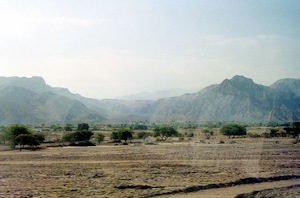
Auf der Fahrt von Lima nach Nazca
| April 22nd: Lima-Nazca.
Departure is set to 10 o'clock. The bus station is crowded and chaotic. Right next to me a couple from England looses their credit cards, passports and money to pickpockets. The gentleman was only not on guard for a few seconds. You have to hold on tight to your stuff, especially money and passport should always be on your body.
The bus ride is fantastic! A modern, air conditioned bus with comfortable reclining seats puts the shame on everything we have in North America.
Outside a very arid landscape is rushing by that is getting more desolate the closer we get to Nazca.
Around 16:00 we arrive in Nazca. Another culture shock. Nazca is not what I expected at all. Somehow I expected a polished tourist town. The Nazca lines are a UNESCO world heritage site and one of the most well known archaeological sites after all. Instead I find a small, dusty, chaotic and rather grimm looking town. It's not exactly high season either and I seem to be the only tourist around. It's hot with 35 degrees Celsius in the shade. I'm really surprised how little developed the area is. The locals don't seem to be to interested in their world heritage site. Trash lies everywhere next to the road, sometimes right next to the lines itself that are partly visible from the bus.
Not too far from the bus stop I see the Hotel Alegria in walking distance. No Taxi stops for me, maybe they don't stop for tourists on Thursdays. So Hotel Alegria it is. It seems fairly new and is really nice inside with a pool, a restaurant and very relaxing atmosphere. The price of $15 per night is a surprise as well as I expected to pay a lot more.
In the evening I take a stroll down the main road of Nazca (there isn't much more than this main road) until I hit the famous (at least to me as I read about it in many books) Hotel Nazca Lines. The hotel was home to Maria Reiche the German Archaeologist and Introvert that researched the Nazca lines for many years and had a huge role in protecting the lines. She was also responsible for building the watchtower in 1976, the only structure from which you can see the lines without using an airplane.
|
| April 23rd:
At 7:30 in the morning I take a Taxi to the little airport of Nazca. The airport is specialized to offer flights over the lines. Everybody I talked to recommended to fly over the lines right in the morning. The light is better as well as the temperatures are not as hot.
Myself and a girl from Argentina are the only tourists on the airport so far and we hire the first flight this morning. The very old Cessna plane doesn't look very promising, but it looks like it has seen many hours of flight, so it will carry us as well.
2 minutes after we get airborne we see the first lines. I can't believe I'm here! I read everything about the Nazca lines and now I see them for myself. Unbelievable.
In reality the lines are even more impressive as you can scale them within the surrounding landscape.
I take photos like mad. I never changed film so quickly in my 35mm Nikon SLR.
Of course we fly over the main attractions the giant animal figures like the bird, the astronaut and the whale. But I'm much more fascinated by the straight lines that are older than the figures. Some of them run for many kilometers over hills and mountains. Some cross each other, some are running parallel. At one point that we fly over, many lines are meeting at one point forming a star.
Back on the ground I hire a Taxi which takes me to the watchtower that the German Archaeologist Maria Reiche built with her own money in 1976. The tower stands about 25km North of the Town of Nazca.
What did the ancient people around Nazca possess to make the lines? What triggered the first man to go out there and start them? Those are thoughts that pop into my head while I sit in the taxi. Here in the middle of the dessert with 30-40 Degrees Centigrade in the shade every day, manual labor if like torture. Some of the lines are 50cm deep and several kilometers long. Even if you assume that several hundred workers worked avery day, the logistical planning alone was a masterpiece.
After the visit and the flight over the Lines I'm convinced about the following:
- The "official" archaeology knows VERY little about the lines of Nazca.
- Anybody that laughs about the PaleoSeti Theory in regards to Nazca has never seen the lines with their own eyes or is doing so out of embarrasment of their own lack of knowledge.
In an official pamphlet that is handed out in the Tourist Information and Hotels in different languages you can read the following statement:
"The most outlandish Theory about the Nazca lines states that it was an Extraterrestrial Spaceport. This Idea is based on the fact that some of the lines look like runways and you can only see them from the sky. Furthermore they say that the "Owl-man" or "Astronaut" is an alien. This theory is - of course - without any reason and logic, but has quite a few followers".
Well what can I say to this BS? Whoever wrote this never read any book on the Ancient Astronau Theory....
- The lines were designed specifically to be viewed from the sky. You can't see a single figure from the ground. If you don't believe it, go to Peru, hop in a plane in Nazcaand check for yourself.
- The lines were not designed for the people that constructed them. It makes absolutely no sense to construct something, that the people couldn't even look at after it was finished.
- In 1998 "El Nino" - the weather pattern triggered by the change of currents in the Pacific - was the reason for strong rain after over 20 years in the Nazca area. One would think that something like that would wipe out most of the realtively shallow lines. But alomost everything stayed intact. I'm convinced that the lines were specifically built in certain areas that included water flow patterns in the area. How ingenious is that!
|
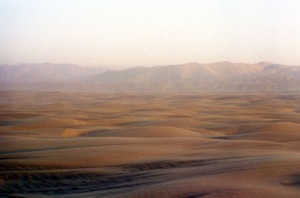
The dessert around Nazca looks like the Sahara in North Arfica

Dann geht es den Pazifik entlang nach Arequipa
| April 24th: I hear in the news that there are plans for a major strike in Bolivia in the beginning of May, just when I would like to visit Tiahuanaco which is just across the Bolivian border. That would be a major setback for me as I really would like to see Tiahuanaco and Puma Punku.
I also heard that despite the site being so close to the border, connections into Bolivia are not the best. The travel guide also doesn't tell me good things about the border crossing.
Is that the end of my Puma Punku dream?
Some fellow travellers in the Hotel tell me that the best way into Bolivia is the longer route via Copacabana
- a peninsula on the south coast of lake Titicaca - and La Paz, the capital and biggest city of Bolivia.
The whole trip is supposed to be pretty time consuming.
Time that I don't have. So many things to see - so little time... I'm also afraid that the altitude will take it's toll on me. I heard so many horror stories. Everybody I talked to agrees, that you have to have several days of peace and quiet, just to get acclimatized. The lake Titicaca, Tiahuanaco and Cuzco are all at an altitude of aorund 3000m or more. Since I have never been in altitudes like these I have no idea on how my body will react.
I decide to get to lake Titicaca as quickly as possible and book a bus ticket from Nazca to Arequipa, the second biggest city in Peru. The distance is about 600km and the duration on bad roads about 10 hours. The bus leaves Nazca at 15:00 and we arrive in Arequipa at 1:00 in the morning. The landscape that went by during the trip was incredibly pretty. Desert landscapes in the Sahara and long, lonely beaches are tourist destinations just waiting to be discovered...
... I'm a bit uneasy driving in a Taxi with a driver doesn't speak a word of English - in fact, he doesn't speak at all - at 1:30 in the morning. We are driving through shady looking parts of town that are almost unlit. Peruvian taxi drivers don't believe in turning on their headlights at night. A good prayer and the virgin of Guadelupe hanging from their rear view mirror seems to be a good substitute. Occasionally there are dark figures standing on the side of the road with machine guns. Or bananas? Who knows, it's dark!
I told - or better pointed on a map - the driver to drive me to a Hotel which the travel guide describes as "friendly and good". As we arrive 30 minutes later, the house the hotel is supposed to be in is as dark as the rest of the city and a big fenced gate locks the entrance with two different locks. There is no "Hotel" sign to be seen. I point to the house and ask the driver "Hotel"? He grunts. Now I'm really worried. Where did he bring me to? I expect a bunch of thugs will be coming around the corner any time now and this will be the end of me. I get out of the car, because I think if there really is a problem I have a better chance outside then in the car.
The driver thinks I will run off, shouts something in Spanish and get's out as well. At this moment a light goes on in the house and a "Hotel" sign is turned on. The locks 'click' and the gate opens. Thank god!
I pay the driver, he grunts again and drives away. He disappears with a non illuminated car into the dark city. Lights are overrated.
A sleepy person sits at the reception wearing a wool hat, mittens and a ski jacket. It has 18 degrees Celsius and it's humid, I wear a T-shirt and I'm sweating. If this guy would know about Canadian winters...
The Hotel is completely empty, I'm the only tourist. I get the best room, which is still distgusting. The bed is of the worst sort, I sleep on my own towels, there is no toilet paper in the bathroom, if you can call it that. But it doesn't matter, at 2:00am after a 10 hour bus ride, sleep is the only thing I can think of.
|

Arequipa. In the background the volcanoe Misti
| 25 April: Arequipa is supposed to be a nice and interesting city with a huge colonial Monastery, says the travel guide. After last nights Hotel recommendation, I'm skeptical, though. Indeed in the morning light the area around the hotel looks a lot more friendly than in the dark at 2:00am in the morning. The guy at the reception warns me that there are a lot of pickpockets and gangs in town and as a single traveler I'm quite vulnerable.
Since I grew up in Bavaria, I have seen many catholic monasteries and I decide to skip Arequipa and move on towards Lake Titicaca right away. I'm on a PaleoSeti trip afterall and want to see Tiahuanaco - I hope it will work out. On the way to a taxi I get warned once more by two pediestrians to watch out, there are many thieves around. Welcome to Arequipa!
I get in a Taxi and drive to the Terminal Terrestre - the bus station. I book a ticket to Puno, a town on the lake Titicaca. The bus leaves at 9:45. A short watch-check reveals it's 9:40! The older gentlemen behind the ticket counter struggles with my long German name. I see sweat forming on his forehead as he types it with one finger on the unbelievably filthy computer keyboard.
Why they have to type in my passport number and age for a ticket within Peru is beyond me.
It's now 10:00 and finally the ticket is printed on the dot matrix printer that is at least 25 years old. Commodore built quality peripherals back then.
"Terminal 139, Senor!", the guy says, followed by a "Vamos!" and "Arriba!". The word arriba I remember from the Cartoon "Speedy Gonzales". I know what it means. I picture a dust cloud behind a mouse with a big sombrero.
"Where is Terminal 139?", I ask. The older gentlemen - I estimate him in his 70s - jumps up with surprising agility that wasn't expected after his 15 minute keyboard ordeal.
"Follow senor", he says, and runs with me to another hall across the street. At 10:15 we arrive at Terminal 139 which I would have never found by myself. The bus should have left 30 minutes ago. Thank god, schedules are just a suggestion in South America.
The trip to Puno is very enjoyable. We drive through beautiful scenery, always uphill towards the Andes. After a while I feel a bit dizzy. I check my GPS, we are at 4500m. Lamas and Alpacas are lying around ver y lazy next to the road. It seems I'm not the only one feeling the altitude, a group of Italian tourists makes good use of the onboard toilet, when they come out of the tiny washroom, they look a bit pale 10 Minutes later. I have a little bit of a headache, but nothing severe.
At 16:00 we arrive in Puno a very nice town on lake Titicaca. Lake Titicaca! I'm really here! It's off season and I quickly find a nice hotel. In the evening I visit a local market. That's when the altitude sickness strikes! I have severe headaches, I'm extremely dizzy and have a hard time breathing. I take to extra strong pain killers and go to bed. Tomorrow I will take it easy!
|
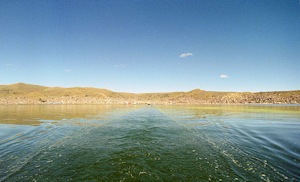
Die Stadt Puno liegt herrlich in einer Bucht am Titicacasee. 
Das Volk der Uros lebte fuer Jahrtausende auf Schilfinseln im Titicacasee. Heute halten ihre Nachfahren diese Tradition aufrecht.

Kinder werden in Schilf-Schulen unterrichtet.
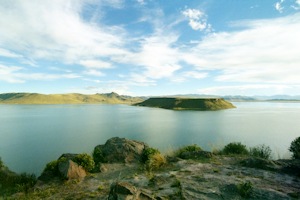
The view in Sillistani is phenomenal.
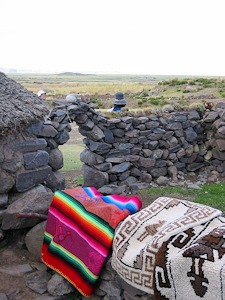
Around Sillustani the people life like hundreds of years ago. The buildings are grey and not impressive. But the textiles show the colorful side of the friendly people....

Das Getreide wird gemalhen wie vor Jahrtausenden. Viele der Inkafrauen tragen die traditionelle Tracht, die ihnen die spanischen Kolonialherren befahlen zu tragen.
| April 26th: Surprisingly I slept very well. I read somewhere that sleep apnia is one sign of the "soroche" or altitude sickness. I don't feel so bad, still a little dizzy, but nothing that would stop me from exploring Puno and surrounding areas today.
I would like to do a tour to the swimming islands of the Uros people. But before that I like to arrange the bus to Tiahuanaco. I find out that the short direct route via the border town of Desaguadero is closed for many weeks now. The other, longer route via Copacabana is still open, but there also problems with a bridge of some sort. The information is very vague and not promising at all. I decide to risk it and book a ticket for tomorrow.
In the meantime I get on a boat to the Uros people. It's a short 20 minute boat ride out to the lake where you already see many of the swimming islands.
The people live here like hundred years ago. The Islands are like little villages, with little stores, a school and some watchtowers. Everything is made from reed plants. Of course, the whole thing is a tourist attraction now, the Uros people don't HAVE to live on the Islands, but the want to keep the tradition alive. If you look closely you will see some solar powered TVs in the back of the huts and you can't shake the feeling that at night some of the inhabitants go home to Puno into a nice, cozy house. My visit takes about two hours and I have the the second half of the day left for something else to do.
With three other trourists from the US I hire a "Collectivo", a minibus to the nearby Pre-Incan Archaeological site of
Sillustani.
I read about Sillustani in an archaeological magazine a few years back. It's a very intriguing site that was used and considered sacred over many thousand years.
The site is located beautifully on a hill top overlooking a stunning landscape with lakes and table mountains.
Several architecture styles are visible. Perhaps the most surprising are stoneage stone circles and underground structures that don't seem to get a lot of attention from the tourists and archaeologists.
The altitude is - literally - mind blowing and breathtaking. 4300m above sealevel slows even the fittest people down significantly.
On the way back we stop at a local farm who's owners offer handmade textiles for sale. I buy a bautiful colored blanket and the farmer invites me in to meet his wife that is making bread in a way that has not changed in thousands of years. In the backyard they raise guinea pigs, a national delicacy in Peru. In most restaurants you will find them as "Cuy" on the menu. I don't think I'm brave enough to dry it....
|
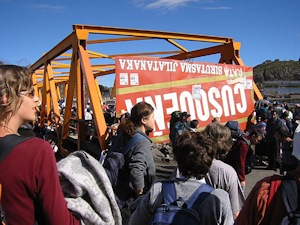
A strike interrupts the trip. A bridge is blocked.
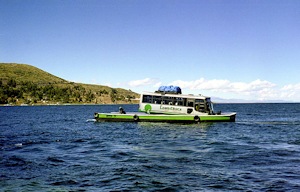
The bus is loaded on a raft and transported across the lake. We had to get out and ride along on a dingy.
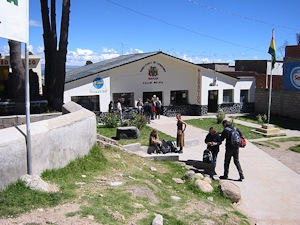
The border crossing between Peru and Bolivia.
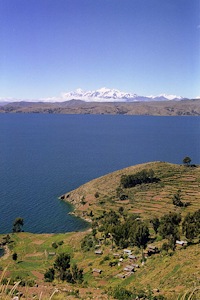
The trip from Puno to LaPaz is simply beautiful. Here the view of Lake Titicaca and the Cordiliera Real, a mountain range in the Andes.
| 27. April: The bus to LaPaz, Bolivia leaves at 7:00am in the morning. We are on the road for about 45 Minutes as the bus driver stops the bus and tells everybody to get out. We are in a town with hundreds of people around. Chaos is all over the place, dust is in the air, chickens, sheep and lamas do not want to come with their owners. Nobody knows what's going on and why we stopped. I see a bridge over the river that flows through the little town. The bridge is bright orange and seems to be the focus of all the chaos. A big road sign is turned upside down and is used to block access to the bridge for any vehicles. Somebody tells me that there is a strike going on in this little town and we have to cross the river - that doesn't hold a lot of water at the moment - on foot. On the other side another bus is waiting and we can continue our trip. There most be 100 busses and trucks and other vehicles parked here. The bus driver tells our group of 6 tourists and 10 locals to stay close together, the situation outside is a bit "on edge".
We cross the river and I see something hanging from the middle of the bridge. I ask on of our group members, a local that speaks a bit of English what the comotion is all about. He tells me that the inhabitants of the town found out that the town's mayor and town counsil was found to be corrupt and pocketed government grants in their own pockets. That's why they blocked the bridge for the last three weeks.
Yesterday the situation took a turn for the worse and the angry mob tried to lynch the mayor. He barely managed to get away. Unfortunately this morning he wasn't this lucky. The mob finally got a hold of him and hanged him from the bridge!
That's what I saw hanging from the bridge... I feel sick to my stomach.
We get in the new bus on the other side and continue on our trip. Nobody speaks for about half an hour, I guess we are all in shock!
About 200km before LaPaz our bus get's loaded onto a ferry to cross the lake and all the passengers ride in a little dingy along side.
The bus is loaded in a very "adventurous manner", the sight is not recommended for safety enthusiasts.
I book a hotel room for LaPaz on the bus, a "mobile travel agent" drives along with us. In a small suitcase he has different broshures for different hotels in several price categories. I find that's a great idea, airlines should do that!
I book a hotel in the highest price category in a nice part of town for $9.
The border control between Peru and Bolivia is very relaxed. Two stamps in the passport, and "Welcome to Bolivia!"
Bolivia is the poorest country in South America. You see that immediately, the houses on the side of the road are in a sorry state. I bottle of 500ml Coca Cola costs $0.10 here, everything is incredibly cheap.
The road from to LaPaz runs along the shores of Lake Titicaca. In the distance I see the snow capped peaks of the Andes. Traditional South American tunes are playing in the stereo overhead. I can't describe my joy to be here, what a dream, I have tears in my eyes.
We arrive in LaPaz around 16:00. We drive through scary parts of town, drug addicts are on the side of the road, the poorest of the poor. Almost every child has a paper bag in their hand, they are sniffing glue.
The bus drops me off at the hotel that I booked on the bus. They know I'm coming, how I have no idea. I didn't see the travel agent use a phone. The hotel is fantastic and in a nice part of town. Right in the hotel is a little booth that offers tours to Tiahuanaco. Tomorrow
at 7:00 I will go!
|
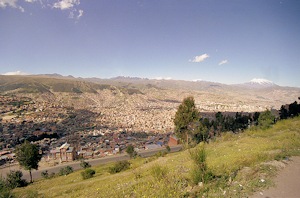
La Paz is a faszinating mix between total chaos and great culture.
| April 28th: 7:00am in the morning the minibus that is supposed to bring us to Tiahuanaco is parked in front of the hotel. "Us" is a small group of tourists, a couple from Munich, Germany (my home town), a guy from Switzerland, a father and son team from Japan and myself. Of course there is the driver and a guide (the world of tourism can't function without a guide, you know). It turns out that the group has great chemistry and we all have the same humor. We all speak German (even the father and son from Japan) and we have a lot of fun during the drive.
After about an hour we arrive in Tiahuanaco. After Nazca another dream comes true for me.
The site is fantastic, I'm impressed. [a closer description of Tiahuanaco you will find here]
Now I would like to visit Puma Punku. I ask the guide. "Puma Punku is closed", he tells me. "What? Why?" I ask. He just shrugs his shoulders and says "those are just a few old stones, nothing really interesting to see. Also there are excavations going on and nobody is allowed in". He points to the van. We have to go back. So he thinks.
I tell him something, that he doesn't expect. "Ok, you go back, I stay here. I want to see Puma Punku and I'm not leaving unless I see it." "It's impossible, sir", he says. "We will see I say, I'm going now and climb over the fence...", I reply.
Now the other tourists get curious. They ask what that Puma Punku is. I tell them that those are very unique ruins, highly controversial. The stoneworks look very modern. Puma Punku is one of the reasons I came all the way from Canada, and I will not get stopped ten meters before the site.
The other tourists agree, they want to see it as well. "Not possible", says the guide. But I'm already on my way to the gate. I pass the gate. The guide is in crisis mode, he never encountered a tourist revolution.
I says something about "guards" and "trouble". I can't see any guards and if I'm in trouble because I want to visit an archaeological site, I say bring it on.
I give the guide 50 Bolivianos (roughly $10) and tell him to stand guard while we visit the site. He agrees and tells me that is somebody asks, we never seen Puma Punku and did a tour of the museum instead. Obviously guides are told by officials not to let tourists enter Puma Punku. We pass the gate and the guard house. I see shoes in the grass that are actually attached to a person. It's a guard that sleeps in the grass. What else would he do, nobody ever comes, as the guides are not leading tourists to Puma Punku. He wakes up and gets up. He can hardly stand, he is obviously drunk. He says something like "not allowed". I point to my camera and say "Prensa!". "ahhhh, prensa...", he says, and winks me through. Two other "revolutionary" tourists follow and the guard lays down again to sleep. We
are in!
Here they lie in front of me, the ruins of Puma Punku! And they are incredible. You have to see them in images, they are hard to describe!
After about an hour of strolling around in Puma Punku - the guide gave up and let's us do what we want - we decide to invite him to the local restaurant for his troubles. The couple from Munich and myself order Llama with gravy and rice. The gravy and rice are tasty, but th Llama is extremely "gamie". We can't eat it. The guide is happy, he will bring it for dinner for his familiy tonight. I think by now he forgave us about our revolution earlier today. We all have a great time and laugh a lot...m
|
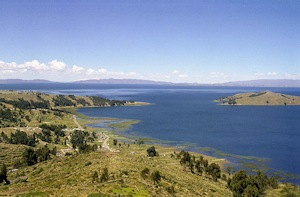
Lake Titicaca | April 29th: Bolivia is a bit of an unstable country. 2003 it was close to a civil war and it is still looking for a stable government. A week before went on my trip, they whole Bolivian goverment stepped back from office, it couldn't solve the major problems the country has.
Now I hear from several sources, that there will be a major strike around the first or second of May that would severely affect the whole country. Strikes in Bolivia can take 6 weeks and more and nothing will move anymore. The people go into complete "hybernation" during a major strike.
Unfortunately, it's time for me to leave Bolivia, I don't want to get stuck. I book the bus back to Peru. This time I purchase a fare directly to Cusco in Peru, the old capital of the Inca empire.
The trip is scheduled to last more then 20 hours.
When we leave LaPaz I see a lot of military presence. Tanks and machine guns on the side of the road are not a calming sight. The soldiers are building barricades on the road every few hundred meters. i have the feeling that I'm on the last bus out...
Two hours later on the border to Peru, I have no problem with the crossing. I'm glad to be back in Peru, as it is a much more stable country. Everybody talks about the strike in Bolivia now.
The following bus ride to Cuzco is the worst I have done so far. The bus is old, hot and sticky and at night there are dark characters entering. Sometimes I think it would have been better to take a plane.
When I arrive at 4:30 in the morning the next day, I hardly can feel my butt.
|
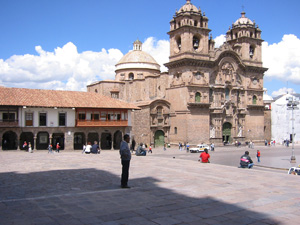
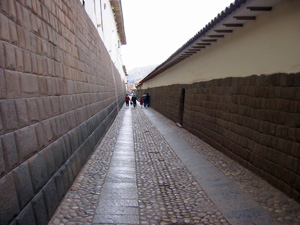
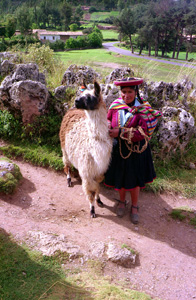
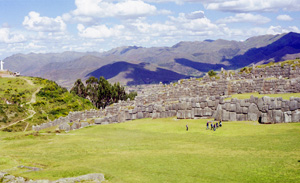
| 30. April: Cuzco is a beautiful city. Nestled within the Andes it has a very nice climate, not too warm and not too old. I plan to start out the day with a sightseein tour on foot. I'm especially interested in the famous Inca walls that one should be able to see all over the city. The Spanih Conquistadors built their buildings right on top of the ancient Inca walls as they provided superior stability during earth quakes.
My Hotel is located on Plaza San Blaz, very central, pretty much everything of interest is within walking distance. I walk down a narrow street towards the city centre and pretty much the first Inca wall I see is the one with the famous 12-sided
stone, a masterpiece of Inca masonary. The Inca perfected building walls without mortar by fitting stone onto each other so precisely that not even a business card can fit between the stones. The city is hustling and bustling full of tourists and locals. A very colorful, happy place. The main town square is bright, open and very picturesque with its two main cathedrals and colonial balconies. I can now see why Cuzco is considered one of the most beautiful cities in South America.
My main goal in Cuzco is the ancient Inca Fortress of Saqsayhuaman which is a few kilometers out above the city. In the afternoon I rent a Taxi that will bring me to it. Another highlight of my trip.
Nothing can prepare you for a visit to Saqsayhuaman! No foto, video or description is doing it justice. My German travel guide is doing a good job, though. Remember this a fairly conservative German travel guide that has absolutely nothing to do with PaleoSeti! It says:
"Whoever sees the gigantic superwalls with their stones that are fitted with millimeter precison into each other and weighing many tons for the first time, is simply overwhelmed.
The walls of Saqsayhuaman seem to have been built by Titans
during the dawn of human kind.
The lower wall is approximately 600 meters long is the most fascinating wall that I have ever seen. To this day it is a complete mystery how such stone giants were transported. The biggest of these stones measures 9x5x4 Meters and weighs well over 350 tons."
There is very little to add to the above, except that the walls are telling us that as long as we are rejecting the PaleoSeti explanation, the mystery will never be solved.
People including myself are walking up and down the walls and are completely mesmerized by what they see. After about half an hour I have to sit down in the field before the walls and I think how lucky and privileged I am to be here.
After a while I start to look closer. The gigantic stones are put together so precisely that you can't fit a piece of paper in between them. This is already impressive in the smaller walls down in the city of Cuzco, but the same precision was used here on a whole different scale. On top of everything the stones are not just any old sandstone that's soft and easily workable but granit, one of the hardest stones known.
What technology might have been in use here?
The best view of the main wall you have at the hill across.
It becomes clear that there are three walls right on top of each other.
I climb further up the hill across the main walls and I can't believe my eyes. Pretty much every rock and stone is carved and altered the granit around here looks like somebody took a knife to butter. It's not butter, it's granit. Some sections over here are ten meter high rock walls that have been polished smooth like modern concrete. Everything looks like a enormous puzzle, a labyrinth made from granit. I come around a corner and stand in front of giant piece of rock that looks like it was turned upside down. There are stairs carved out of it and the run upside down.
In every rock I find, cut-outs, nishes square and round, rectangles, cricles and bows. What purpose did they serve? An archaeologist friend of mine thinks it was the "practise ground" for the carvers that worked on the big walls. An apprentice ground of sorts. That makes sense in theory, but when you stand in front of them you realize that some of the rocks and carvings look much more weathered then others, so whatever was going on up here was going on over a long period of time.
The carvings up here are MUCH older then the walls of the fortress.
Up here the word "ruins" doesn't apply. These are more then ruins. With "regular" ruins you can at least make out somewhat of an original purpose. A house, a temple or something welse. Here everything is just confusing and every attempt to apply a purpose is just a guess.
|

| Mai 1st: First thing in the morning I'm on my way to Saqsayhuaman. again. I want to investigate the "ruins" above Saqsayhuaman further. I have a lunch packed, as I want to hike from Saqsayhuman to the Genko Grande, a myserious rock weighting stunning 250000 tones. Archaeologists tell us that the Genko Grande is a natural rock formation as it would be impossible for humans to move it, while local folklore is convinced that the ancients moved it there and in the process it killed several hundred workers. A typical of Archaeology only accepts as truth what they want
I'm back in the hotel around 16:00. The rest of the day I visit the monastery "Santo Domingo" that was built onto the heart of the Inca empire, the Temple of the sun.
Thank god the Spaniards made an exception and didn't destroy the old temple completely. The built the monastery walls around the ancient structure, leaving some of the interiour intakt. It's a good thing that they did that as an earthuake in 1950 destroyed most of the colonial walls that the Spaniards built. Only the Inca walls come out completely undamaged. In fact even more of the Inca walls have been unearthed by this earthquake. Those walls are now open for visits. The stone masonry of the Suntemple is of the finest quality in Inca buildings. The Inca walls are exceptionally earthquake proof. Today would say that a lot of science went into the walls to achieve this. The "interlocking" stones, the precise cuts that doesn't leave any room for the stone to move and the trapezoid way the windows and doors are built contribute to this extraordinary feature.
I'm lucky today. It's a holiday today and the monastery is closed. But right when I want to enter, a munk comes out and asks me where I'm from. I tell him I'm a German living in Canada he says his brother lives in Germany and he visited Canada a few years back. He askes me if I wanted to come in and
visit the place since I came all the way today. He can let me in if I promise not to damage anything. He says that with a twinkle in his eye. I
don't say no to that. I can't believe it, I have the place completely for myself!
This way
I can take lot's of photos without any other tourists around. Also no guide that tells me all kinds of stories.!
|
|
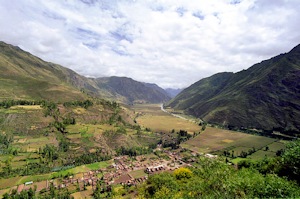
From the ruins of Pisaq one has a fabulous view upon the holy valley of the Inca
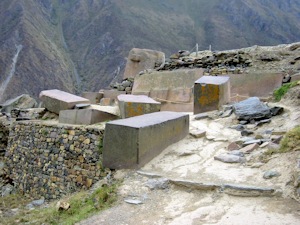
Ollantaytambo is one of the sites in the world where huge blccks of stone have been used like toy blocks.
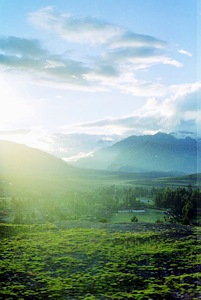
In the evening the light creates magical views.

The farmers and artisan market in Chinchero is highly recommended and lasts until very late into the night.
| May 2nd: Today I'm planning a trip to the Holy Valley of the Inca. I want to see the sites of
Pisaq and especially Ollantaytambo.
I reach Pisaq around noon. The ruins are scattered around the different hilltops. It's about an hour hike to the main site. The hike is not easy in this high altitude. Up here you can definately feel your lungs while walking.
Like most Inca ruins the main site of Pisaq is astronomically aligned around an even older Megalithic site. Parts of this Megalithic site were carved out of only one piece of granit. Around this site the Inca built there structures with their famous very accurate stoneworks. These types of wall were only used for important sites. Other walls on less important sites were "run-of-the-mill" stone walls that can be seen everywhere around the world.
The view of the valley is here especially nice. I'm glad I visited.
Wie die meisten Inka Ruinen sind auch die Haupt-Ruinen in Pisaq um eine
astronomisch ausgelegte megalithische Anlage herum gebaut. Dieser Teil der
Anlage wurde aus einem einzigen Granitblock herausgemeiselt. Um diese Anlage
herum bauten die Inka ihre grandiosen Mauern, die sie in ihrer Perfektion
uebrigens nur an Orten bauten, die sie als ganz besonders wichtig empfanden.
Die meisten Inkamauern sind naemlich ganz "normale" Mauern, die es auf der
ganzen Welt zu besichtigen gibt.
Die Hauptanlage in Pisaq ist ziemlich klein und unspektakulaer, die grandiose
Lage der Anlage lohnt aber einen Besuch (und den etwas anstrengenden Auf- und
Abstieg) allemal.
Our next stop is the site of Ollantaytambo. For most tourists Ollantaytambo is just a train stop on the way to Machu Picchu. For those in the know Ollantaytambo is one of the most mysterious archaeological sites in Peru, if not in South America. The reason for is the temple high on a hill. This temple is pretty unusual. The stone slabs used here are monstrous and weigh several hundred tons. On top of everything the stones were dragged up a narrow passage and just left there. Everything is unfinished and it looks like the builders left in a hurry. [read more about Ollantaytambo on this page]
The fantastic day ends with a visit to Chinchero. The drive there through the holy valley of the Inca with the sun setting through the mountain tops, illuminating the whole valley in a greenish yellow tint is absolutely spectacular.
Chinchero is an idyllic little town with a big square and a nice little church. Today is market day. The market runs well into the night and with candle light it is one of the most intriguing sights. The market doesn't feel like the usual tourist markets. It seems much more genuine.
It is the end of a fantastic day. At midnight I return to the hotel in Cuzco, that costs a stunning $8 per night by the way and is actually very nice.
Tomorrow I will sleep in and take it easy. |
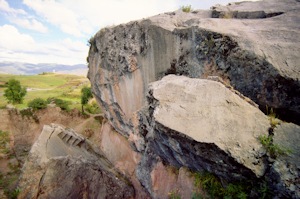
| May 3rd: I sleep in and have a late breakfast. I finally can eat a bit more. In this altitude everything you eat causes the body to use a lot of energy to digest. You eat and right after you feel exhausted and tired. That's on part of the effect of the altitude you rarely hear about.
In the afternoon I visit the Quenqo again as it is only 20 minutes away from the hotel. I don't want to do much today as tomorrow will be a long day again. I booked a tour to Machu Picchu.
|
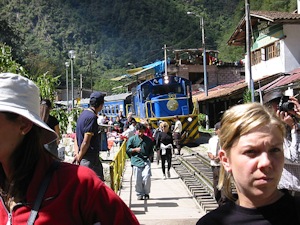
Im Dorf Aguas Calientes rollt der Zug ein und bringt Tuoristen an das Ziel Machu Picchu. 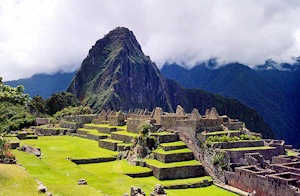
Die Bergkuppe im Hintergrund heisst Wayna Picchu. Auch dort oben haben die Inka gebaut.

Up here it's hard to take a bad picture.
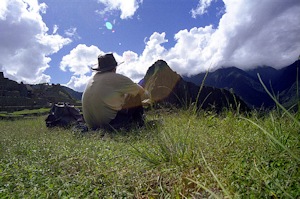
Enjoying the view...
| May 4th: The travel guide says: "If you haven't seen Machu Picchu, you haven't seen Peru!" And nobody should say that I haven't seen Peru. Machu Picchu is certainly THE tourist magnet of South America. In Peru everything is pretty inexpensive but Machu Picchu is the exception. The government is operating a train that goes from Cozco to Agua Calientes, the little town below the ancient site of Machu Picchu. The train ticket and the entrance fee to the site is rather expensive. If you think you can ger there cheaper or you can escape the tourist masses, think again.
Of course hiking enthusiasts can walk the Inca Trail, but this means booking three months in advance. I also can't see the enjoyment
of walking for one week in that altitude.
The trip starts at an ungodly hour. At 5:00am I sit in the train at the Cuzco train station. The car features wooden benches, no luxury here just "adventure". The offical trains to Machu Picchu are all painted blue and yellow, so tourists can't miss them.
The train climbs out of Cuzco with a switch back system as Cuzco is in a bowl between high maintains. To make it accessable to Cuzco was quite an engineering challenge a guy from the US tells me. He is a train enthusiasts and takes the ride to Machu Picchu mainly because of the train ride. We all have different interests, he comes to Peru because of the trains, I come here because Aliens might have been here in the past. Diversity is what makes us human, if we would all be the same, we would loose our soul.
Our train is slowly rolling by the poorest parts of Cuzco and it makes me wonder where the money that all the tourists spend to see Machu Picchu actually goes.
.
The train ride is really nice, I take photos of the jungle outside. My train enthusiast friend takes photos inside the car. I learn that the benches we sit on are orginal from 1931. I think I saw a monkey on the tree outside...
The 122km trip from Cuzco to Agua Calientes takes 4 hours. To walk the Inca Trail takes 4 days or more. I prefer the train.
The little town Agua Calientes is a bit of a nightmare. Everything is geared towards tourism. Souvenir shops of the worst sort line the streets. It's amazing that everywhere in the world where there are big attractions, the surroundings morph into the same cheap rip-off culture. No matter if you visit the leaning tower of Pisa, the Eifel tower, the pyramids or Machu Picchu, it seems that
if we want to look at something cultural we seem to have the urge to buy the cheapest plastic crap possible and fake Rolex watches. What's amazing is that in all my years of traveling all over the world, I have never seen anybody that buys that plastic crap. Simple rules of the free market should take care of that, one would think.
The surroundings of Agua Calientes are quite nice. The little town is surrounded by spectacular mountains, lush green jungle with all kinds of exotic animals in the trees and the river Urubamba flows right through town.
The river is currently extremely high. Three weeks before I arrived extreme rainfall caused landslides that cut the town of from the rest of the world for almost 5 days. Lot's of tourists were trapped in here and food and other supplies had to be airlifted with helicopters.
Every year nature shows us that to get to Machu Picchu is still an adventure. Sadly every year hikers die on the Inca trail because of landslides and exhaustion.
Stories like these are supressed by the government in fear that the tourists will stay away and therefore rarely get published in Western news.
Today the weather is nice, though. The air is hot and humid. Of course you can hike up to Machu Picchu if you want. A winding path leads up to the sight and the climb takes about 6 hours. But I choose the easy way and take one of the shuttle buses that brings me right up a switch back road to the main entrance of the site. For $180 per night you can stay up here in the Luxury Hotel "Machu Picchu Ruins" and can either have some of the most magical sunsets ever or get totally rained and fogged out. It all depends on your luck.
Today I'm lucky. The weather couldn't be better. The majestic cumulus clouds make the site look even more impressive.
What Aguas Caliente lacks of ambience, Machu Picchu makes up for ten times. The site is hard to describe. Hundreds of photos are taken every year, but very few photographs come close to what the site looks in person. My theory "if you want to get to the best places on Earth - you have to follow the ancients" comes here to life.
The site is located high up a mountain top and is not visible from Aguas Calientes below.
Th views are simply stunning. No matter which direction I look, I feel I'm in a movie rather then being really here. The temperature is a fantastic 24 degrees Centigrade and a warm, light breeze sweeps around. All the tourists that clogged up Agua Calientes below seem to have disappeared. I don't know were they went. Maybe the site is just to big and the crowds are lost in it or they stayed down there and admire the plastic souvenirs.
Whatever the reason, I get some photos without crowds and just enjoy th site. For about 3 hours I stroll around, sit in the grass and enjoy the surroundings. What a magical moment!
I take the last bus back down to Aguas Calientes to catch the last train to Cuzco.
We are about two hours into the trip - it's already dark outside - as all over sudden the train stops in the middle of nowhere. It's hot and sticky in the train as all the lights turn off. It's a full moon night and the jungle outside is turned into an eery blueish tint. It's really quiet now in th train as well as nobody knows what's going on. If something like this happens there is always an undrlying fear that a train/bus is held up by bandits. We all heard the stories although I have never met anybody that has actually happened to.
I have a little headlight with me that I bought extra for the trip. It seems
I'm the only one. Other tourists gather around me. I guess I'm not the only one with an uneasy feeling. A coupl from Israel, asks "Can we sit with you?".
After 45 minutes a female train conductor finally goes through the car. She doesn't have a flashlight either. "Problema?", I ask. "No Problema", she answers. We all start laughing. It seems that it is the most normal thing in the world that the train stops in the middle of the jungle without any lights on.
When she comes back 15 minutes later she says that her supervisor will inform us soon.
I wonder what he will inform us about as there seems to be no problem.
Southamerica at it's best!
After 2 hours in the dark we still don't hear any Diesel engine sound, nor did we see any supervisor giving us an update. We are slowly preparing for a long, dark night in the train.
At around midnight - some people are already asleep on the floor - we hear the sound of a Diesel engine coming to life. The lights go on. A big cheer goes through the train. The train rolls again.
Now the conductor tries to make up time by driving way to fast. Why would it matter now? The vintage train and all the cars make greeking sounds. Now we are looking at each other. Words like "The idiots will kill us..." are heard.
At the next stop in Ollantaytambo, I don't want anymore and get out. Thank god there is still a bus to Cuzco here. It must have waited for the train to arrive. After half an hour the bus finally arrives in Cuzco. I'm really tired, but there is yet another little surprise.
There are no taxis at this station, they all went home already. The bus driver tells me and the Israeli couple, that also took the bus, that the next Taxis are about 15 minutes walk away. "That way!", he points. I ask if he wouldn't be so nice to drive us there, it must only be a couple of minutes with a vehicle. He refuses, his shift ended 4 hours ago. It's bed time now.
So the three of us head out in the night. Scary. We arrive at the taxi stand 10 minutes later. We walked fast.
|
[Edit 2014: During this trip to Machu Picchu in 2004, I shot the photo below with my old Nikon FM2 film SLR. The weather that day was exceptional and the clouds formed this almost 3 dimensional effect. It is one of those rare photographs of a lifetime. The photo is one of my best selling photographs and over the years it paid for the trip in 2004 many times over. This photo represents to me the essence of still photography: To freeze a moment in time. Everytime I look at this photograph I can smell the air that day, feel the wind on my skin. It was one of the moments I felt truely happy.
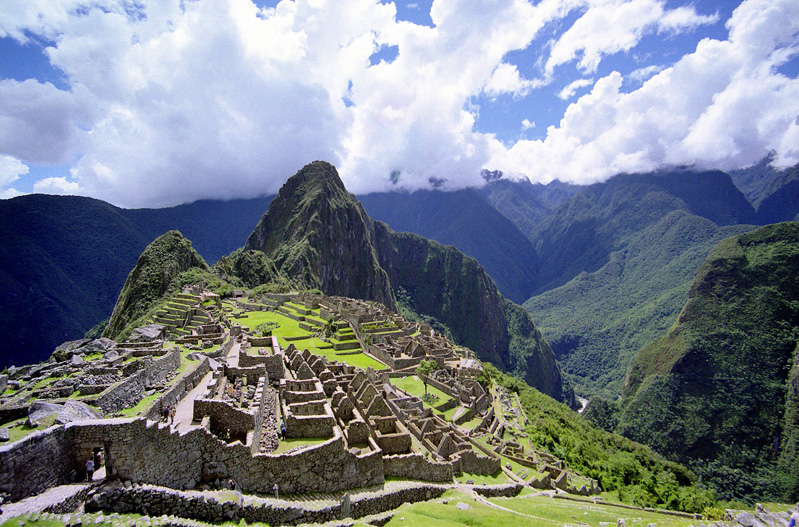
May 5th: When I go for breakfast around 9am I meet other tourists who used the train from yesterday. They say the train broke down once more and they spend another three hours between Ollantaytambo and Cuzco. Thank god I got out when I did.
I don't feel like doing much today. I stroll through Cuzco and do a little shopping for loved ones at home. A nice silver necklace for my girlfriend, some ponchos for my mother and sister.
If you like artisans and high quality wool products, Cuzco is heaven on Earth. The prices are great. Next time I come here, I won't even bring a jacket. I just buy it here. That saves on baggage and improves the local economy.
After all the ancient sites I visited it feels nice just to hang out in Cuzco. I'm always wary to eat in restaurants during my trips, as I don't want to get sick and save money, but today I go to a nice looking one right across the hotel. It was recommended by other guests and the friendly guy at the reception. It turns out that the food is excellent, very tasty. The neighbouring table get's served "cuy", Guinea Pig on a stick. It is still VERY recogniseable as such. I don't think I could eat it. It's a rodent, no thanks! I still have the tast of Llama in Tiahuanaco on my tastebuds...
In the evening I book a flight back from Cuzco to Lima for tomorrow. It is unbelievable how easy everything works here regarding transportation. Our western oriented countries could learn a thing or two about public transport from Peru and Bolivia. Cheap, effective and always available.
|
May 6th: My trip is coming to an end. Today I'm going back to Lima and tomorrow I'm going home. The flight to Lima from Cuzco only takes 1.5 hours. I arrive at 9:00. I book another room in the Hotel I was before. The name is Hotel El Patio. I highly recommend it if you are in Lima. I stroll one last time through Lima and visit the Anthropology museum again.
|
May 7th: I'm going home. What a great trip it was! I will definately be back.
| | |

